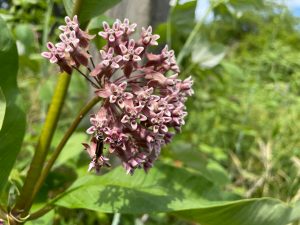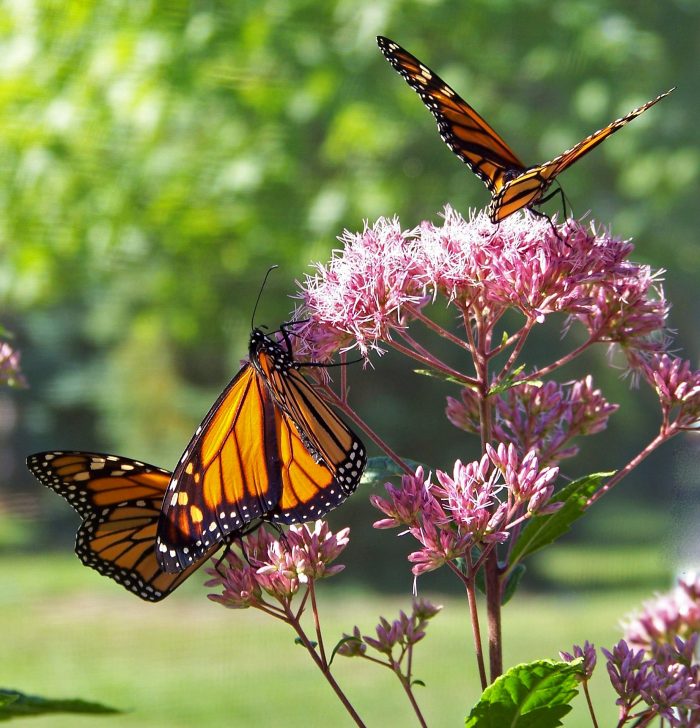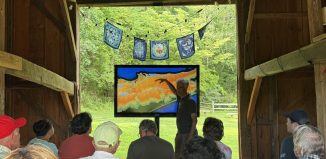Nature Matters: Monarchs
By John L. Turner
While snipping off shoots from a few tomato plants growing on the edge of the vegetable garden, a fluttering movement caught my eye. Turning to look in the direction of a small stand of Common Milkweed pinched against the garden’s deer fence, I watched as a Monarch Butterfly danced from one milkweed plant to another. After a minute or two she left (in addition to the egg-laying habit of females, you can distinguish male and female by the presence of two black dots on the hind wings of male Monarchs and the thicker black wing veins of females) and I had a chance to see the results of her activity — four tiny white eggs laid on the underside of milkweed leaves.
The butterfly’s dance was a dance of life, for she was creating the next generation. Various milkweed species serve as host plants for Monarch caterpillars, provisioning them with all the food they’ll need to develop into adults.
Feeling a tad bit paternal, I checked on the eggs daily. On the fourth day I was in for a surprise. On the underside of a milkweed leaf was a small caterpillar about a third of an inch long. With the diagnostic colors of white, black, and yellow I knew it was a very young Monarch. As the next few days went by the hungry little caterpillar grew, reaching about half an inch in length.
When I next checked in, it had molted its skin for the first time, which sat like a tiny rumpled shirt stuck to the leaf surface. I anticipated seeing several more molts before the caterpillar was fully grown. However, when I inspected the next day there were no signs of the caterpillar, not in the form of nibbled milkweed leaves, nor the caterpillar itself despite an extensive search in which I turned over every milkweed leaf in the small stand of plants. It was gone. Disappeared. Nowhere to be seen.

The disappearance of this caterpillar serves as a metaphor for the species, as the Monarch butterfly is disappearing before our eyes. The Western Monarch population which overwinters in southern California is critically endangered with a few thousand butterflies separating it from extinction and in the past two decades Eastern Monarchs have declined by 85%, primarily due to the loss of milkweed in the Midwest, killed by herbicides designed to reduce competition with agricultural crops like soybeans and corn.
Here the story turns to Monsanto, the chemical industry giant. Monsanto developed, and for many decades manufactured, ROUNDUP, the most widely used herbicide in the United States. And while herbicides can kill unwanted weeds, they can also have a negative effect on crops, a problem Monsanto solved by developing genetically engineered corn and soybeans, immune to ROUNDUP’s effects.
Now, Monsanto could sell both countless tons of soybeans and corn kernels and the herbicide that’s effective at eliminating competing plants, like milkweeds, all made the easier by the farmer not having to worry about the herbicide killing the crops. Spray away!
Not surprisingly, in the past twenty-five years ROUNDUP use has increased 20-fold. The result of all this spraying? The Midwest has lost 99% of its milkweed stands. Wonderful profits for Monsanto but deep peril for Monarchs — so deep that a petition to have the butterfly added to the federal Endangered Species List has been submitted to the U.S. Fish & Wildlife Service and accepted with merit.
The life cycle of the Monarch is complex, unique, and remarkable. By the middle of March adults begin to disperse northward from their overwintering sites in Mexico with virtually all funneling through Texas. These females lay eggs on milkweeds and the young that hatch out become the 1st generation; the adults die but the eggs hatch, the caterpillars grow and the adults move north before repeating the process.
The butterflies repeat the process, several hundred to a thousand miles to the north, so by the time we’re seeing Monarchs here on Long Island it may be the 3rd or 4th generation of butterflies for the year. These northward bound generations are much shorter lived than the southbound generation, individuals of which can live for six months. Few other insects undergo such long-distance migrations or have generations part of an annual cycle that behave so differently.
In autumn, the last generation of Monarchs move south, leaving the eastern United States (we see them as they flutter past or perhaps nectaring on fall blooming wildflowers) on their way to one of a dozen or so major colonies situated in the oyamel fir forests scattered in the mountains of central Mexico, where, for the next five or so months, they’ll overwinter.
The climate conditions in these evergreen forests are ideal for Monarchs, a range of cool-to-cold temperatures that allows them to enter a metabolic pause. This can be risky though, as sometimes temperatures drop below freezing and the butterflies perish in huge numbers.
These winter colonies provide another way to measure the Monarch’s status: by looking at the extent of their collective size, measured in acres. The colonies are assessed annually and the trend in the last couple of years has been cause for alarm. This past winter (2020-2021) the colonies covered a little more than five acres, the lowest amount in five years; in 2019 they totaled just shy of 15 acres.
Once Monarchs arrive on Long Island females quickly seek out milkweeds on which to lay eggs. And here an ages-old battle plays out between the plant and the animal. The caterpillar eats leaf tissue that the milkweed doesn’t want to provide. So milkweeds, living up to their name, defend against this by leaking latex-like sap, a poisonous liquid containing cardiac glycosides in an attempt to gum-up the works. This sometimes works with newly hatched caterpillars occasionally dying, not from the poisons but from the stickiness of the sap. But the caterpillars have a trick up their sleeve — they feed in a pattern that blocks off the flow of latex to the portions of the leaf upon which they subsequently feed, without the worry of sticky sap.
Monarchs are unaffected by, and in fact are immune to, the poisonous sap, with recent research finding the species has undergone three mutations that negates the damage caused by the liquid. Remarkably, the caterpillar is able to incorporate the plant’s poisons into its own tissues making it poisonous and highly distasteful to birds, a fact quickly learned by inexperienced birds and which is reinforced by the bright and bold colors of the Monarch (you can imagine this lesson being lost on birds if the Monarch was an indistinctive, brown-colored butterfly).
Young birds quickly associate the butterfly’s bright coloration (known as aposematic coloration) with their poisonous qualities and leave them alone.
If you wish to protect Monarch butterflies there’s a few things you can do to help ensure the future for “North America’s best-known and most-loved insect.” The first is to plant milkweeds, its host plant. Common milkweed is best but swamp milkweed and butterflyweed work too. Stay away from tropical milkweed which isn’t native and is much less effective at growing caterpillars. While you can buy milkweed seeds, better to collect seed pods from local plants and use the seeds once removed from the pods, making sure to let them become cold hardy.
The second is to plant wildflower species that provide nectar for resident and migrating Monarchs. If you live along the coast, a highly desirable native plant that Monarchs enjoy is seaside goldenrod. Other favorable plants include many aster and goldenrod species, Northern Blazing Star, Bee balm, New York Ironweed, and Joe Pye Weed.
Third, move away from using pesticides and other garden and lawn chemicals.
Two weeks later another female Monarch visited the edge of the garden and laid several eggs. A few hatched and the caterpillars have prospered. So, perhaps a few more Monarchs will survive to soon participate in the southbound journey to the mountains of Mexico.
A resident of Setauket, John Turner is conservation chair of the Four Harbors Audubon Society, author of “Exploring the Other Island: A Seasonal Nature Guide to Long Island” and president of Alula Birding & Natural History Tours.







